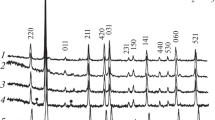Abstract
Data on fabrication of hydrogen-bearing ceramics by methods of “soft” chemistry, i.e., topotaxic exchange of mobile metal cations for H+ (H3O+) or NH4 + in the ready skeleton crystalline structure of the corresponding niobates (niobotungstates) and tantalates (tantalotungstates) preliminarily synthesized by high-temperature solid-phase reactions are presented. A unique combination of electrical (proton conduction) and chemical functions of such ceramics made it possible to create sensors for a whole spectrum of analytical devices, effective ion exchangers and sorption materials.
Similar content being viewed by others
REFERENCES
V. L. Balkevich, Technical Ceramics [in Russian], Stroiizdat, Moscow (1984).
I. L. Trubnikov, Crystal Acids of Titanium, Niobium, and Tantalum and Their Electrical Properties. Author's Abstract of Candidate's Thesis [in Russian], Rostov-on-Don (1984).
A. Teitsma, M. Sayer, S. L. Segel, and P. S. Nicholson, “Polycrystalline hydronium β/β”-alumina: A ceramic fast proton conductor,” Mater. Rest. Bull., 15(11), 1611–1691 (1980).
V. B. Nalbandyan, Niobates and Tantalates of Univalent Elements and Solid Solutions Based on Them. Author's Abstract of Candidate's Thesis [in Russian], Rostov-on-Don (1982).
J.-L. Fourquet, G. Ory, G. Gauthier, and R. de Pape, “Mise en evidence des deux types de pyrochlore et de leurs solutions solides dans les systemes TlxNbO2 + x F1 – x et TlxTaO2 + x F1 – x ,” Compt. Rend. Acad. Sci., C.271(14), 773–776 (1970).
I. N. Belyaev, T. G. Lupeiko, V. B. Nalbandyan, and V. E. Abanina, “On thallium niobates and tantalates,” Zh. Neorg. Khim., 22(11), 3126–3128 (1977).
V. B. Nalbandyan, I. N. Belyaev, and K. A. Tyshlangov, “Hydrogen-bearing solid solution of a pyrochlore type,” Zh. Neorg. Khim., 27(10), 2462–2470 (1982).
V. B. Nalbandyan, I. L. Belyaev, and I. L. Trubnikov, “A method for fabricating pyrochlore-like niobium and tantalum acids and solid solutions based on them,” USSR Inv. Certif. No. 1111996, Otkr. Izobr., No. 33 (1984).
V. B. Nalbandyan, I. N. Belyaev, B. S. Medvedev, N. G. Bukun, and I. L. Trubnikov, “A method for obtaining hydrogen-bearing pyrochlores,” USSR Inv. Certif. No. 1057472, Otkr. Izobr., No. 44 (1983).
F. V. Kul'ba and V. E. Mironov, The Chemistry of Thallium (Complex Compounds) [in Russian], Goskhimizdat, Leningrad (1963).
C. Michel, A. Guyomarc'h, and B. Raveau, “Nouveaux echangeurs cationiques avec une structure a tunnels entrecroises: Les oxides A12M33O90 et A12M33O90 _12H2O,” J. Solid State Chem., 22(4), 393–403 (1977).
I. L. Trubnikov, “Synthesis, proton conduction, and sorption properties of crystalline niobium, tantalum, and titanium acids,” in: Mater. Conf. Young Scientists of the Faculty of Chemistry of Moscow State University, Part 1 [in Russian], MGU, Moscow (1984), pp. 126–129.
I. L. Trubnikov, L. A. Solov'ev, and T. G. Lupeiko, “Synthesis of wollastonite in salt melts,” Steklo Keram., No. 12, 15–16 (1989).
V. B. Nalbandyan, I. L. Trubnikov, S. I. Zhuikov, B. A. Shmatko, and T. I. Ivleva, “Ceramic proton conductors based on tantalotungstates and their use in hydrogen detectors,” in: Solid Electrolytes and Their Analytical Use, Abs. Rep. III All-Union Symp., Minsk, February 6 – 8, 1990 [in Russian], Universitetskoe, Minsk (1990), pp. 24–25.
V. B. Nalbandyan, I. L. Trubnikov, N. G. Bukun, and B. S. Medvedev, “Proton conduction of ceramic niobium and tantalum acids with a pyrochlore-type structure,” Zh. Neorg. Mater., 22(5), 836–840 (1986).
I. L. Trubnikov, V. B. Nalbandyan, and I. A. Zubkova, “Effect of ammonia on conduction in crystalline niobium, tantalum, and titanium acids,” Electrokhimiya, 22(10), 1410–1414 (1986).
V. B. Nalbandyan and I. L. Trubnikov, “Conductance, volt-ampere characteristics, and heat resistance of cells with proton conductors: ammonium tantalotungstate,” in: Solid Electrolytes, Abs. Rep X All-Union Conf. on the Physical Chemistry and Electrochemistry of Ion Melts and Solid Electrolytes, Ekaterinburg, October 27 – 29, 1992, Vol. III [in Russian], Inst. Vysokotemper. Electrokhimii, Ekaterinburg (1992), pp. 60–61.
I. L. Trubnikov, V. B. Nalbandyan, S. I. Zhuikov, and V. I. Nepogodin, “Solid proton conductors for analyzing gases and liquids,” in: Chemists of the North Caucasus to National Economy: Abs. Rep. II Region. Conf. Grozny, 4 – 9 Sept. 1989 [in Russian], ChIGU, Grozny (1989), p. 55.
I. L. Trubnikov and V. B. Nalbandyan, “A sensor for determining the concentration of ammonium in a gas medium,” USSR Inv. Certif. No. 1141326, Otkr. Izobr., No. 7 (1985).
V. N. Chebotin and M. V. Perfil'ev, The Electrochemistry of Solid Electrolytes [in Russian], Khimiya, Moscow (1978).
Author information
Authors and Affiliations
Rights and permissions
About this article
Cite this article
Trubnikov, I.I. Hydrogen-Bearing Ceramics. Refractories and Industrial Ceramics 41, 396–400 (2000). https://doi.org/10.1023/A:1011353916708
Issue Date:
DOI: https://doi.org/10.1023/A:1011353916708




